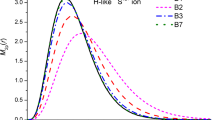Abstract
Photoionised plasmas are common in astrophysical environments and new high resolution spectra from such sources have been recorded in recent years by the Chandra and XMM-Newton satellites. These provide a wealth of spectroscopic information and have motivated recent efforts aimed at obtaining a detailed understanding of the atomic-kinetic and radiative characteristics of photoionised plasmas. The Z-pinch facility at the Sandia National Laboratories is the most powerful terrestrial source of X-rays and provides an opportunity to produce photoionised plasmas in a well characterised radiation environment. We present modelling work and experimental design considerations for a forthcoming experiment at Sandia in which X-rays from a collapsing Z-pinch will be used to photoionise low density neon contained in a gas cell. View factor calculations were used to evaluate the radiation environment at the gas cell; the hydrodynamic characteristics of the gas cell were examined using the Helios-CR code, in particular looking at the heating, temperature and ionisation of the neon and the absorption of radiation. Emission and absorption spectra were also computed, giving estimates of spectra likely to be observed experimentally.
Similar content being viewed by others
References
Bailey, J.E.: Private communication (2008)
Bailey, J.E., et al.: Neon photoionization experiments driven by z-pinch radiation. J. Quant. Spectrosc. Radiat. Transfer 71, 157–168 (2001)
Foord, M.E., et al.: Charge-state distribution and Doppler effect in an expanding photoionized plasma. Phys. Rev. Lett. 93, 055002 (2004)
Gonçalves, A.C., et al.: A new model for the warm absorber in NGC 3783: a single medium in total pressure equilibrium. Astron. Astrophys. 451, L23–L26 (2006)
MacFarlane, J.J.: Visrad—a 3-d viewfactor code and design tool for high-energy density physics experiments. J. Quant. Spectrosc. Radiat. Transfer 81, 287–300 (2003)
MacFarlane, J.J., Golovkin, I.E., Woodruff, P.R.: Helios-CR—a 1-d radiation-magnetohydrodynamics code with inline atomic kinetics modeling. J. Quant. Spectrosc. Radiat. Transfer 99, 381–397 (2006)
MacFarlane, J.J., Golovkin, I.E., Wang, P., Woodruff, P.R., Pereyra, N.A.: Spect3d—a multi-dimensional collisional-radiative code for generating diagnostic signatures based on hydrodynamics and PIC simulation output. High Energy Density Physics 3, 181–190 (2007)
Timoshenko, Woinowsky-Krieger: Theory of Plates and Shells. McGraw-Hill, New York (1959)
Van Hoof, P.A.M., et al.: Modeling x-ray photoionized plasmas produced at the Sandia Z-facility. Astrophys. Space Sci. 298, 147–153 (2005)
Author information
Authors and Affiliations
Corresponding author
Rights and permissions
About this article
Cite this article
Hall, I.M., Durmaz, T., Mancini, R.C. et al. Modelling, design and diagnostics for a photoionised plasma experiment. Astrophys Space Sci 322, 117–121 (2009). https://doi.org/10.1007/s10509-008-9930-4
Received:
Accepted:
Published:
Issue Date:
DOI: https://doi.org/10.1007/s10509-008-9930-4




